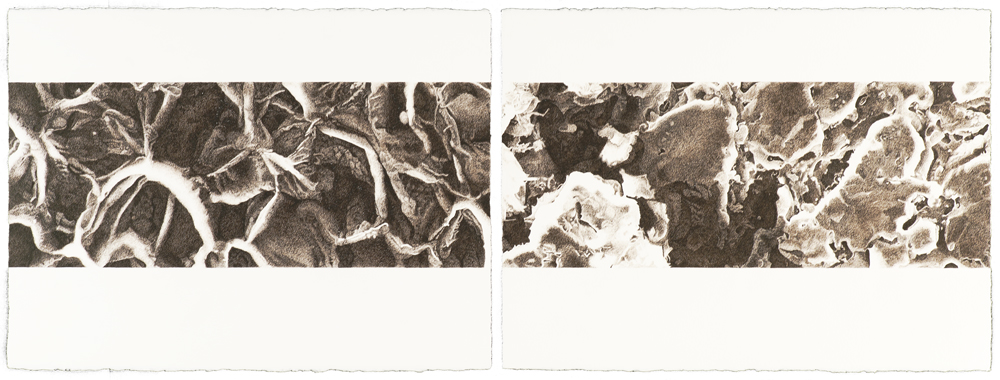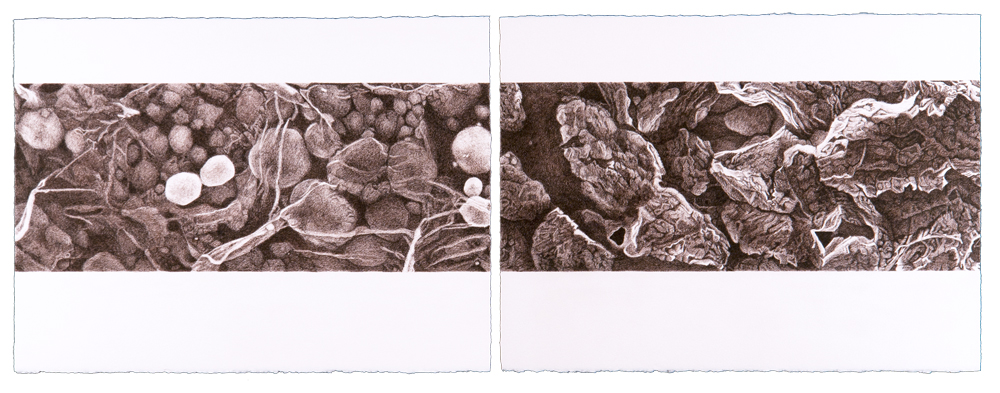Name: Karen Gustafson
Which came first in your life, the science or the art?
Art came first. I was constantly drawing on our walls when I was young kid, frustrating my parents. The immediacy of putting a mark on a surface, watching an image develop as those individual marks accumulate, still inspires me.
My love of nature developed early on in my life. When I was 8 years old, my family moved to Northern Minnesota from the Twin Cities. We built a home on a wooded lot. It was incredible to walk out our backdoor and see where the trails would take me. I still remember how awe-inspiring it felt to discover for the first time, vast fields of wilderness adjacent to the woods. The tall grasses and the diversity of plants were fascinating. I loved exploring. To have this immense space to roam and play as a kid was amazing.



Which sciences relate to your art practice?
Biology, botany, food science, and nutrition.
From the start, my work has been centered around imagery from the natural world, predominately plants, their medicinal qualities, and patterns found in the natural world. In graduate school, I was feeling stuck with my imagery, so I decided to visit the biology library. I was stunned to see plant micrographs for the first time. (This was in the early 90s.) I found several books filled with micrographs of plants at various stages of growth and reproduction. The forms were captivating.
“I was stunned to see plant micrographs for the first time…The forms were captivating.”
Karen Gustafson
My work circled back to microscopy in 2012. I had been reading several books on food and its relationship to human health. The inspiration for my Raw to Processed series occurred while talking with a curator about an older micrograph-based painting. I mentioned I would love to see what specific foods looked like under a scanning electron microscope (SEM). I was fortunate to have access to a SEM through my job. (I teach art at Normandale Community College.) I used a SEM to explore the same food in opposing states to capture the topography of a food, its underlying patterns, and its structure. I find that pattern recognition is a key way for me to grasp and process information.
My newest work continues this exploration of plants and their relationship to health through stitching plants from an ancient herbal, the Vienna Dioscorides (512 A.D). It is a recension of a Dioscorides pharmacopeia, De Materia Medica, written in c. 65 A.D. De Materia Medica was the main pharmacological text for over 1500 years. Several of the nearly 400 plant paintings depicted in the Vienna Dioscorides are still known to us today. These plants create a connection to this ancient text, linking past to present. I revisit the role of an embroidered sampler. Rather than collect stitches, patterns, and colors, I preserve medicinal plants.



What materials do you use to create your artworks?
I generally have used traditional materials, such as watercolor paints or felt tip ink pens, on heavy weight cold press paper. I use multiple layers to slowly build up the work. I can achieve rich varied colors and a broad range of tones through this process. The painting or drawing slowly comes into “focus,” as I spend months developing it.
Recently, I have transitioned into drawing with thread using a sewing machine and the technique of free-motion embroidery. I can work relatively quickly while balancing control and chance as I stitch. I draw the plant’s main form on dissolvable fabric and then place this fabric on top of a piece of translucent organza. These two fabrics are held tight in an embroidery hoop. With free-motion embroidery, you are able to stitch in any direction. I decide how I want to create the plant’s internal structures as I work, focusing on its life-like qualities rather than on botanical accuracy. To finish the drawings, I place them under running water to dissolve away the top stabilizing fabric, trim the edges, and complete them with a roll hem.


Artwork/Exhibition you are most proud of:
I am most proud of my current series, Vienna Dioscorides, and the Raw to Processed drawings. I completed seven diptychs for the Raw to Processed series. Each one is just over 60 inches in width and took approximately four months to create. They required delving extremely deep into their complex imagery while sustaining a physical stamina and commitment that required intense energy. Working in that way was very rewarding, but I needed to make a change.
With the Vienna Dioscorides drawings, the commitment to the work has transformed into working intensely for shorter durations of time. A work can be completed within a week or two. I have stitched 51 plants, in the three plus years since I began the series. I envision an immersive exhibition featuring over 60 drawings as a culmination to this phase of the project. I am honoured and grateful for the strong interest individuals have had in both of these series. Additionally, I am thankful for the rich conversations that have occurred while discussing the works, their inspiration, and the techniques involved.




Which scientists and/or artists inspire and/or have influenced you?
Pedanius Dioscorides is the first to come to mind. To imagine the commitment he had to documenting, compiling, and writing De Materia Medica at the time he did is astonishing. Equally as influential are the many unidentified artists who created the plant paintings in the Vienna Dioscorides manuscript, and the plant paintings that inspired their work.
Other artists include Albrecht Dürer, Leonardo da Vinci, Michelangelo, and Raphael. The sensitive sculptural line work they use in their prints/drawings is stunning. Another strong influence on my work are the prints included in ancient herbals, such as those by Otto Brunfels and Leonhart Fuchs, and the human anatomy prints in Andreas Vesalius’ On the Fabric of the Human Body.
Contemporary influential artists include William Kentridge and Tara Donovan. I find myself studying their work for how masterful and creative they are with their imagery, processes, and materials.

Find out more at Karen Gustafson’s website, Twitter, or Facebook.
Share this Post

